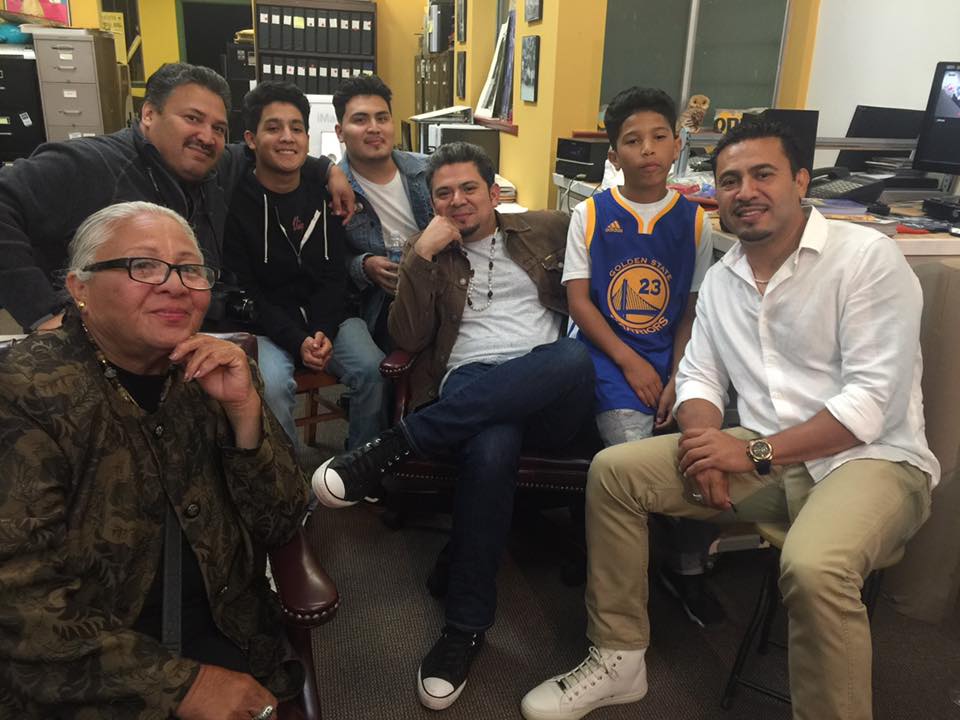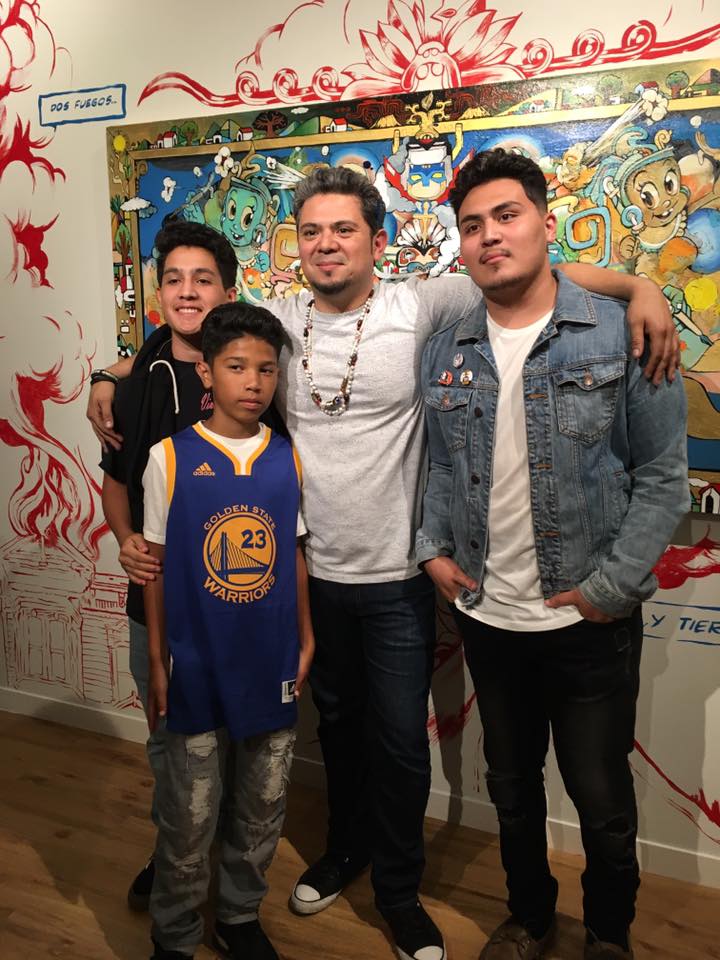This article appeared originally on MissionLocal.org
Artists unveiled a new mural today on Folsom Street near 23rd Street as an ode to the victims of gun violence and a reminder of the Mission’s culture of street art.
The artists created “Birds of the Americas” over three weekends as friends, neighbors and others watched, fed and celebrated the artists.
Photo by Clara-Sophia Daly
“It felt really loving out on the street, all types of people from all walks of life, all cultures, would cruise by and hang out and say ‘wassup’,” said graffiti writer Alvaro Lacayo. “A lady brought us beers, and a family brought us cookies. Some lady brought Mexican food. I’ve never received this type of gratitude before – people want to be a part of the community.”
Josué Rojas or ‘KID CEYBA’ is the executive director of Acción Latina, and the mastermind behind the new mural. He says the mural is a “lyrical tribute to those who have passed,” and the experience was a tribute to urban culture.
Josue Rojas, the lead painter and mastermind of new mural. Photo by Clara-Sophia Daly
“The Mission already is the world’s biggest outdoor gallery. So we’re keeping that tradition going,” said Rojas who first learned to paint in 1995 at Precita Eyes, a community arts education nonprofit that has been teaching Mission youth to paint since 1977
In fact, the 40-year old artist’s first mural from that year was painted just across the street at Cesar Chavez Elementary School. It was the Urban Youth Arts component of the existing mural which said “with love magic and art, we shall overcome.” That part of the mural has since been painted over.
Mural across the street at Cesar Chavez Elementary. Photo by Clara-Sophia Daly
Murals “contribute to a sense of safety, contribute to a sense of vibrancy,” said Rojas who was born in San Salvador, and came to the mission as a child migrant in 1980 and got his “mural education in S.F. and learned East Coast abstract expressionism” at Boston University where he got his masters in Fine Arts .
“This is how we show love to our neighborhood, to our community and the people who are from here. And that’s how we pay tribute. That’s how we make memories. That’s how we speak into the future.”
The building on Folsom Street is a former restaurant supply store that used to auction off old dishwashers and stoves in its backyard. The trees in front of the building provided shade for the artists and community members to rest and eat a banana or have a slice of pizza.
Over three weekends in September, Rojas and his team transformed the former ‘eye-sore’ into a colorful artwork. Photo by Clara-Sophia Daly
Pablito Ruiz Arroyo paints one of the birds from the top of scissor lift. Photo by Clara-Sophia Daly
Mural in progress. Photo by Clara-Sophia Daly
Photo by Clara-Sophia Daly
The new mural depicts three birds. On the left is a Torogoz, or the El Salvadorian national bird. It’s turquoise, green and orange hues are an unofficial tribute to Andres Guardado, an 18-year-old Salvadoran-American man shot in the back and killed by a Deputy Sheriff from the Los Angeles County Sheriff’s Department on June 18, 2020.
Painting of a Torogoz, or the El Salvadorian national bird. Rojas said he ‘kept fallen community members in mind’ as he painted the birds’ Photo by Clara-Sophia Daly.
The Toucan at the mural’s center is a homage to Sean Monterossa, whose nickname was ‘Tucan.’ The 22-year-old was fatally shot on June 2 by Vallejo police. Rojas said that as they painted, the artists kept those who have departed in their minds. “The birds of Central and South America are the birds that represent us, so they represent our fallen.”
Image of the Toucan which is the centerpiece of the mural and honors the life of Sean Monterossa. Photo by Clara-Sophia Daly.
On the right of the mural is a depiction of a Quetzal, the national bird of Guatemala. This bird honors Amilcar Perez-Lopez and Luis Gongora Pat, the former an immigrant from Guatemala who was killed by the San Francisco Police Department and the latter a homeless Mexican immigrant the police shot and killed in the Mission District in 2016. Both of these men were killed within five blocks of the mural.
Quetzal, the national bird of Guatemala. Photo by Clara-Sophia Daly
“We are painting the mural for the same reason we play music. Murals are an external expression of a community’s internal values. And for our community to see that a mural is going up even during these conditions, during the fire. For them to see we are coming together, making something beautiful during this time,” that is important, said Rojas.
The pandemic has been particularly difficult for the Latinx community, which represents only 15 percent of the population , but at least half of San Francisco’s coronavirus cases.
Rojas brought together a diverse team of artists, a mix of painters, graffiti writers and street artists – all with a common goal: to create a colorful mural on this wall for the community.
Rojas and his team are showing that despite all that is happening in the world, the tradition of art and culture the Mission will persevere. Pablito, one of the painters explains that “As an artist, this is our way of life. Not our job, it’s our duty. It doesn’t matter if a comet is hit, we’d still be painting.”
Rojas ‘wrote’ or painted Ceiba, which is a Mayan tree of life. “The roots go to the underworld, and the branches go to heaven,” Rojas said. In Mayan culture, it symbolizes the axis of the earth and acts as a connection between the underworld and the sky to the terrestrial realm.
Josue Rojas painted ‘Ceiba’, which is the Mayan tree of life. Photo by Clara-Sophia Daly
Throughout the days the mural was painted, community members hung out to support the artists.
A DJ Sake One brought refreshments for the muralists, and Ernesto Ruiz who works for Craftsman Tool Rental provided the scissor lift so the muralists could reach the top of the building to paint.
Roja’s playlist of 90’s hip hop blasted on a stereo and provided the musical backdrop while the muralists painted with brushes and cans of spray paint.
Vanessa Solari Espinoza or ‘Agana’, one of the artists, first learned graffiti from Rojas over 15 years ago through Visual Element, which was part of the East Side Arts Alliance in Oakland.
It’s “very cool to paint with your mentor,” Espinoza said. Originally, from Oakland, she now lives and raises her one and three year old children in Richmond.
Agana stands beside her portion of the new mural where she painted ‘Agana’ in tropical colors.
Photo by Clara-Sophia Daly
Our ‘cultura’ is being mystical, and to Espinoza, “The birds represent the spirits of people lost and when you see the birds, you can see the reflections of the souls of the folks.” Agana is also part of an all-women crew of street artists called Few and Far Women – she hopes this mural will raise awareness about nature and protecting the earth.
On one Saturday night, Agana painted with a headlamp late into the evening, and Rojas cheered her on as she put finishing touches on her portion of the mural.
Agana stands in front of the mural around 9:30pm on a Saturday night. Photo by Clara-Sophia Daly
‘Agana’ finished portion of the mural featuring bright tropical colors and Guava. Photo by Clara-Sophia Daly
Alvaro Lacayo or “More” was born and raised in Bernal Heights, and is a lifetime ‘graf’ or graffiti writer who loves the camaraderie surrounding graffiti, street art and painting murals.
He focuses on the derivation of letters and is able to trace back the lineage of each letter he writes to specific street artists, explaining that he “comes from a generation of graffiti that looks into where style is from.” He knows the direct lineage of where the letters he writes are from, and has mentors that have influenced his approach.
Alvaro Lacayo’s in front of the mural. Photo by Clara-Sophia Daly
At age eleven, he would “borrow a book of graffiti from his neighbor and copy the letters.” He fell in love with the letters of New York artist Dondi White, a grandmaster of graffiti. And one of his mentors, Vulkam taught him to fully understand how his letter structure developed. Like, where an arrow, or little chip coming off the bar comes from. He painted his alter ego “More’ on the mural in the lettering style he learned from past generations.
Alvaro Lacayo’s portion of the mural.
Photo by Clara-Sophia Daly
Pablito Ruiz Arroyo or ‘Pablito Something’ a 35-year-old painter from Bolivia who ended up in San Francisco six years ago was the main painter of the South and Central American birds. Ruiz Arroyo mixes traditional painting with graffiti, and was the only artist using brushes instead of spray paint.
“Birds are free,” he said. “They fly. So it’s a poetic way to express the freedom that earth was unable to grant these people.”
Pablito Ruiz Arroyo or ‘Pablito Something’ Photo by Clara-Sophia Daly
Celebrated street artist Aaron de la Cruz painted the black geometric shapes that tie the mural together.
Twick, described by Rojas as the “king of spray paint and Mayan art,” has been doing graffiti and street art for 37 years and is a ‘heavy hitter’ in the Mission.
Graffiti artist Twick stands in front of Kukulkan, the mythical deity of the feathered serpent which he painted on the mural.
Photo by Clara-Sophia Daly
Twick stands for ‘The Wicked Inter City Kid’, and is his name or alter ego. He started learning the art of graffiti on the streets of the Mission when he was 13 and now serves as a mentor for people like Bay Area rapper Dave Steezy, who came by to help him paint the mural.
Twick works construction during the day and paints murals, draws and tags to “keep his soul happy.” He says “expressing himself through art is life therapy.”
Graffiti artist Twick’s rendition of Kukulkan the mythical deity of the feathered serpent which he painted on the mural.
Photo by Clara-Sophia Daly
On this mural he painted Kukulkan, the mythical deity of the feathered serpent to go along with the birthing theme of the mural. “It’s just us artists vibing off each other and it’s been good positive energy vibing with these artists,” Twick said of the experience.

























































